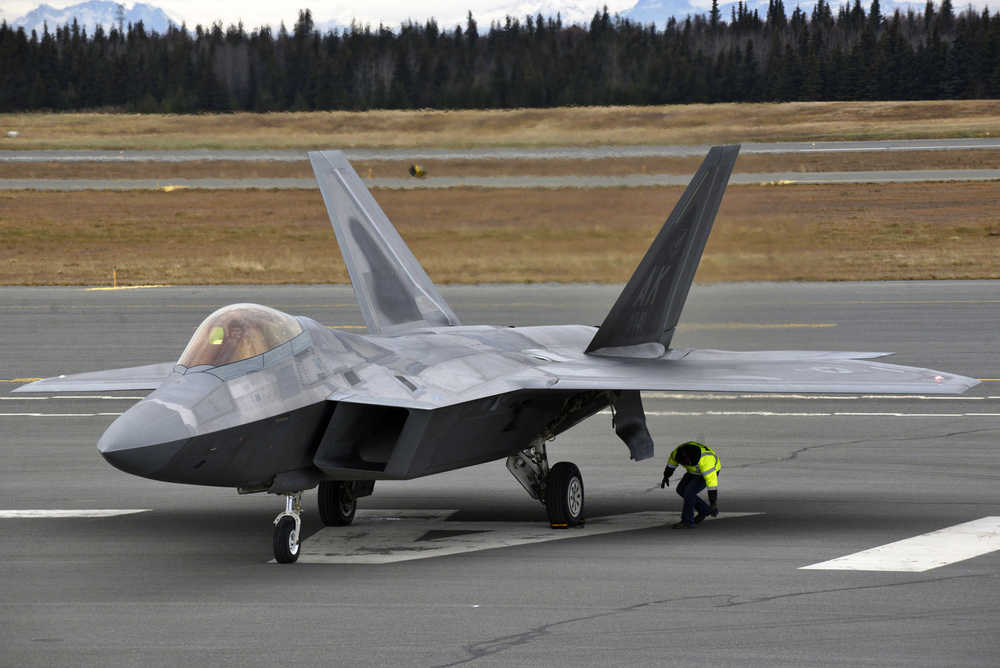A pair of F-22 “Raptor” fighter jets — from the U.S. Air Force’s 525 squadron and the Air Force Reserve’s 302nd squadron, both based at Elmendorf Air Force Base in Anchorage — became the first of their kind to land at the Kenai Municipal Airport when they touched down at 11:45 a.m. Friday.
The pilots came to Kenai to examine the possibility of using its airport as a place to land in case of bad weather.
“We’ve been working with (the Air Force) for the past month, and they’re on a fact-finding mission that they’ll compile in a report to their leadership and see if they can use Kenai as a divert,” said Kenai Airport Manager Mary Bondurant.
While on the ground, the two F-22 pilots spent about two hours talking with Kenai airport workers, Crowley Fuel Service and the Kenai Fire Department about the logistical, technical and safety and security requirements of the two jets. The F-22 pilot spoken to for this story asked not to be named because of personal security concerns, citing the possibility of militant retaliation attacks against individuals associated with U.S. air strikes in the Middle East.
A stealth fighter, the F-22 costs $143 million per unit, according to an Air Force fact sheet. The Air Force operates 187 of the fighters, having ended their production in 2011. The F-22 flew its first combat missions in the U.S. intervention in Syria in September 2014, and has since performed about 3 percent of the air strikes against Islamic State militants in Syria and Iraq, according to DefenseNews.com.
The F-22s stationed at Elmendorf fly training missions in specially designated areas north of Anchorage. If fog or other conditions prevent them from landing at Elmendorf, they presently use the airfield at King Salmon Air Force Station — about 284 miles southwest of Anchorage — or Fairbanks’ Eielson Air Force Base as alternate landing sites. Under some conditions, the Kenai Airport would be a more economical choice.
“When we’re higher up — coming back home from the airspace, we’re at higher altitude — it’s not that much of a fuel hit for us to come down here,” the pilot said. “It’s only about 60 air miles.”
The pilot estimated that using Kenai as alternate landing site could in some circumstances save about 1,000 gallons of fuel, cutting down on flight costs accordingly. Information released by the Air Force in 2013 estimated the operating cost of an F-22 at around $68,000 per hour of flight.
The pilot wrote in an email that the Kenai airport meets the minimum requirements for an F-22 landing, including a runway longer than 5,000 feet. The pilot said landing on Kenai’s 7,830 foot runway had been easy, though an ideal runway would be about 2,000 feet longer. Another ideal feature would be a removable cable across the runway, which a landing jet could catch hold of with an onboard hook in case of a brake failure. But lacking these things doesn’t disqualify Kenai as an alternative landing site.
The navigational aids at the Kenai airport, however, don’t meet certain Air Force policies to allow F-22 landings. Bondurant said the Federal Aviation Administration, rather than the city, owns and manages the navigation aids at the Kenai Airport. The pilot said Air Force officials are discussing the necessary changes with the FAA.
The pair of F-22s left Kenai around 2 p.m. and flew north for training exercises in airspace near Talkeetna and Sleetmute before returning to Elmendorf. The pilot said no future F-22 landings are planned at the Kenai airport.
“This is just to set a precedent, that we can land here and get what we need,” he said.

